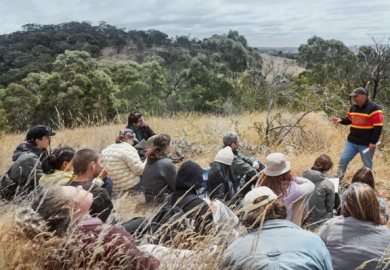Ever since the Nazi genocide of the Jews established itself as a distinct field of study, it has been the object of two equally distinctive discourses. The first, which comes out of traditions of studying the Third Reich as a polity, has generally focused on the evolution of persecution and destruction against the background of Nazi state formation, war and national community-building. The second, by contrast, has tended to organise itself around the label “Holocaust studies” and to conceive of the genocide as an interdisciplinary problem space. The former has been disproportionately anchored in the Germanophone scholarly community, the latter more in the anglophone world, where it has typically focused more intensively on Jewish experiences and perspectives as well as on those of the killers.
David Cesarani, whose death last October robbed the study of the “Final Solution” of one of its genuine pioneers, was one of the few historians who confidently straddled these two fields. As the energetic director of the Wiener Library during its most fertile period, he was instrumental in driving forward the study of the mechanisms of mass murder; later he wrote a well-regarded biography of Adolf Eichmann, Eichmann: His Life and Crimes. Yet he was equally at home, and arguably more pioneering still, when writing about Jewish experiences, contributing a series of insightful studies of refugee politics and international responses to the catastrophe over the years. The successful integration of these two perspectives is the overarching achievement of this superb book.
As far as Jewish experiences are concerned, Cesarani is at pains to demonstrate the hugely diverse ways in which persecution affected different communities (not just from country to country, but within them too), the sense of uncertainty and, at the same time, the profound sense of shock that accompanied the violence. Sometimes it took a while for communities long accustomed to abuse to realise that this was persecution out of the ordinary; in other instances, the unprecedented brutality was met with disorientation and disbelief. Responses varied greatly not only because of context, however, but because of choice.
Cesarani is highly sensitive to the dilemmas faced by some Jews (ghetto elders or policemen, for example), recognising that the choices they faced were usually not real choices at all, and that the invidious positions in which they had been placed constituted part of their torture by the Germans, for whom, in turn, this was sport. In other cases, however, Jews had room for manoeuvre, and they could use it on behalf of either themselves or others; sometimes, indeed, they could exercise it at others’ expense. Some responded well; some appallingly; most fell somewhere in between – what better way of demonstrating that, contrary to the phantasmagorical image of them present in the mind of their persecutors, the Jews of Europe were just ordinary people like everyone else. Cesarani is, however, sharply critical of the laissez-faire economic policies implemented by ghetto elders in Poland during the war, noting that they exacerbated pre-existing distinctions between wealthier and poorer Jews and compounded the already appalling suffering of the latter unnecessarily.
Foreign governments fare little better in Cesarani’s account. Again, it took many ambassadors some time to register the reality of what was occurring, but long after they had had ample opportunity to figure it out, attitudes remained ambivalent. Cesarani underlines the increasingly restrictive response of the British state to the refugee crisis in 1938-39, and delivers an excoriating critique of the Foreign Office’s stance during the Bermuda Conference of 1943. It is not difficult to work out what he would have made of the government’s stance in the current refugee crisis.
What of the machinery of murder itself? In Cesarani’s account, it is decidedly low-tech, and it is decidedly clunky. For all that advance press and marketing blurbs have characterised Final Solution as an emphatically revisionist account of the unfolding of genocide, its most noteworthy characteristic is its strikingly confident reanimation of much older explanatory models. In his emphasis on the absence of coordination, on the confused and haphazard quality of the persecution, and on the conflicting pressures that produced it, Cesarani’s narrative recalls that of Karl Schleunes’ 1970 study The Twisted Road to Auschwitz; elsewhere, one cannot help but recall the work of the similarly inspirational, and also recently departed, Hans Mommsen. In Cesarani’s descriptions of the relationship between wartime exigencies and the onset of the Final Solution, many of his insights recall those of the Swiss scholar Philippe Burrin’s account, Hitler and the Jews: Genesis of the Holocaust (first published in French in 1989). This is an observation, not a criticism: in an age in which too many scholars see aggressive revisionism as the shortcut to scholarly stardom, one of the many impressive aspects of Cesarani’s approach is his consistency in judging arguments on their merits, not their novelty.
Eschewing the imagery of industrial murder, Cesarani also insists on the low-tech quality of the extermination process itself. Haphazard deportations along single rail tracks led to rickety, improvised killing centres that broke down frequently. Not only does Cesarani remind us, moreover, that millions of Jews were shot rather than gassed, but he also underlines that rifle butts, bayonets, boots and fists were as much the tools of mass murder as those on which we conventionally focus. The genocide comes across as an interlinked series of vicious, massive pogroms that drew not only on an ancient hatred but also on an ancient knowledge of “how to do it” – how to humiliate, how to terrorise, how to kill, and how to do so in a ritualised fashion that communicated the anti-Semitic underpinnings of the acts. Some of the individual stories that Cesarani uses to illustrate this are unusually horrifying, even by the standards of this topic, but he handles them with care, compassion and sensitivity.
Neither are collaborators spared his critical scrutiny. This genuinely panoramic account, which surveys events from Greece to Denmark, and from Libya to Russia with equal authority, makes very clear that the genocide was, in Cesarani’s memorable phrase, “a coalition effort”. What, though, of the main partners in that coalition? The one obvious gap in the book lies in the absence of a sustained discussion of ordinary German perpetrators or the society from whence they hailed. Whether this reflects a pragmatic judgement born of the need to organise an already complex history into a coherent book, or rather marks an implicit comment on the amount of scholarly energy that has gone into understanding the mentalities of the killers over the past two decades, we cannot know. It does mean that Wehrmacht soldiers, policemen and members of the SS come into focus comparatively rarely, and that “the Germans” on occasion come across somewhat as ciphers, much as “the Jews” tended to do in an older generation of literature.
This is, nonetheless, a brilliant book. Some historians – not many – get more exposure for their work. But there are far fewer of whom it could be said that their career was genuinely so important. This book may remind us of who and what we have lost, but as a legacy to a field it is hard to imagine a finer piece of work.
Neil Gregor is professor of modern European history, University of Southampton.
Final Solution: The Fate of the Jews 1933-49
By David Cesarani
Pan Macmillan, 800pp, £30.00
ISBN 9780230754560
Published 28 January 2016
Vivi Lachs’ doctoral supervisor in history was David Cesarani. Her tribute to his academic mentorship was published on Times Higher Education’s website shortly after his death.
POSTSCRIPT:
Print headline: Genocide: clearly, it was a ‘coalition effort’
Register to continue
Why register?
- Registration is free and only takes a moment
- Once registered, you can read 3 articles a month
- Sign up for our newsletter
Subscribe
Or subscribe for unlimited access to:
- Unlimited access to news, views, insights & reviews
- Digital editions
- Digital access to THE’s university and college rankings analysis
Already registered or a current subscriber?




